How to identify wild birds and attract them to your gardenUpdated 18 hours ago

Introduction
Welcome to the wonderful world of garden birds! Whether you’re sipping your morning tea or taking a stroll in your garden, the chirping and fluttering of birds can add joy to your day. Our guide introduces the 25 most common birds likely to visit your garden. We will help you identify these feathered friends and share tips on attracting them to your garden regardless of where you live in the UK. Wild bird numbers in the UK are dwindling so any help you can provide is great.
Why Garden Birds Are Important
Wild birds play a crucial role in your garden’s natural ecosystem. They help control pests by eating insects, including aphids and slugs, which can save your plants from damage without using chemicals. Birds such as thrushes and blackbirds are particularly good at this. They also contribute to plant health by pollinating flowers and spreading seeds, helping your garden thrive naturally – always welcome.
Birdwatching: A Growing Trend in the UK
Birdwatching, or ‘birding,’ has become a popular hobby, especially with the increasing awareness of nature’s therapeutic benefits. Observing birds can be a stress-reducing hobby. It requires little equipment to get started—ideally, a pair of binoculars and some curiosity are all you need!
What You’ll Learn in This Guide
By the end of this guide, you’ll be able to recognise common birds likely to visit your garden, understand their habits, and know how to make your garden more appealing to them. We are going to cover:
- Identifying Garden Birds: Learn to spot differences between species by observing their colours, sizes, shapes, and songs.
- Bird Conservation Tips: Find out how you can help protect bird populations right from your garden. There is plenty you can do to help wild birds thrive.

Why Garden Birds Matter
Have you ever wondered why that cheerful chirping from your garden feels so uplifting? Garden birds are not just a joy to watch; they play essential roles in maintaining a healthy garden ecosystem and beyond. Let’s delve into the reasons why these feathered visitors are invaluable to our gardens:
Wild Birds as Natural Pest Controllers
One of the most beneficial roles of garden birds is their appetite for pests that can damage your flowers and vegetables. Many common garden birds, such as Robins and Blue Tits, feast on insects like aphids, caterpillars, and beetles. By doing so, they naturally keep pest populations under control, reducing the need for chemical pesticides. This helps your plants thrive and keeps your garden more organic and safe for wildlife and your family.
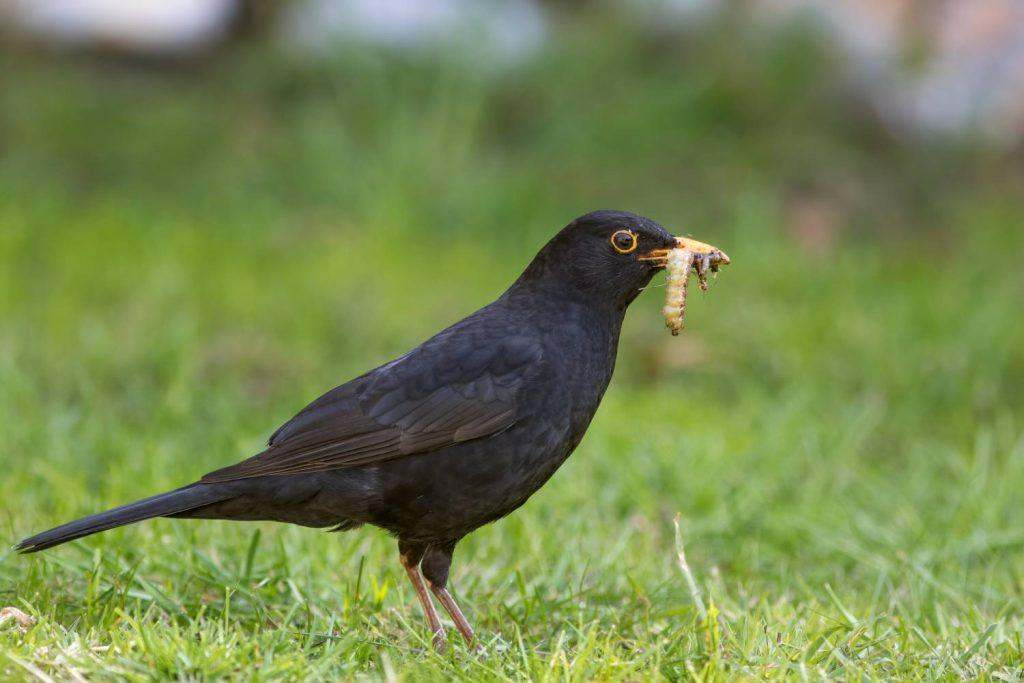
Pollinators and Seed Dispersers
While birds are often overlooked when we think of pollinators, many species, such as the charming goldfinch or the vibrant siskin, play a part in pollinating flowers as they move from plant to plant in search of nectar. Wild birds contribute to seed dispersal. As they snack on berries and fruits, they distribute seeds through their droppings, encouraging biodiversity and helping with the natural growth of plants in your garden.
Ecosystem Balance
Birds are vital to the garden ecosystem. Their activities help maintain balance by controlling pests, aiding in plant reproduction, and even cleaning up by eating weed seeds and dead plant material. Plus, they’re part of a more extensive food web that includes predators like hawks and owls, which helps keep the ecological cycle running smoothly. There is more to birds than you realise.
Boosting Human Wellbeing
The presence of birds in the garden can significantly enhance our mental health and well-being. Watching birds has been shown to reduce stress, anxiety, and depression. Listening to a bird song can relax the mind and uplift the spirit.
Engaging with nature through birdwatching encourages physical activity and can be a serene, meditative practice. Gardens of any scale are a wonderful way of improving overall health and fitness; encouraging wildlife is just one extra way to benefit.
The Science Behind the Benefits
Numerous studies have underscored the importance of birds in our gardens. For instance, the British Trust for Ornithology research highlights garden birds’ crucial role in insect control and also pollination. Additionally, environmental psychologists have noted the positive effects of birdwatching on human psychology, emphasising the therapeutic benefits of connecting with nature, which is widely appreciated.
For further reading on the ecological and psychological benefits of garden birds, the Wildlife Trusts provide a treasure trove of information. Explore their resources here to learn more about how you can participate in and benefit from wildlife conservation.
By understanding and appreciating the role of garden birds, we can create better habitats for them and enhance our garden experiences. Isn’t it wonderful how these tiny creatures can significantly impact our world in the garden and beyond? Let’s make our gardens a welcoming haven for them, one bird feeder at a time!

Common Garden Birds in your garden and how to identify them
There are so many beautiful birds in the wild that can visit your garden, so it is worth learning more about them to enjoy their visits even more. Recognising which birds are visiting your garden, you can take steps to encourage other species to visit your garden.
In this guide, we list 25 wild birds most likely to visit your garden, how to recognise them, what you can provide to encourage them to visit and their favourite plant types.
- Robin (Erithacus rubecula)
- Blue Tit (Cyanistes caeruleus)
- Blackbird (Turdus merula)
- Starling (Sturnus vulgaris)
- House Sparrow (Passer domesticus)
- Goldfinch (Carduelis carduelis)
- Chaffinch (Fringilla coelebs)
- Great Tit (Parus major)
- Wren (Troglodytes troglodytes)
- Greenfinch (Chloris chloris)
- Song Thrush (Turdus philomelos)
- Magpie (Pica pica)
- Sparrowhawk (Accipiter nisus)
- Coal Tit (Periparus ater)
- Jackdaw (Corvus monedula)
- Long-tailed Tit (Aegithalos caudatus)
- Pied Wagtail (Motacilla alba)
- Woodpigeon (Columba palumbus)
- Collared Dove (Streptopelia decaocto)
- Dunnock (Prunella modularis)
- Bullfinch (Pyrrhula pyrrhula)
- Nuthatch (Sitta europaea)
- Jay (Garrulus glandarius)
- Mistle Thrush (Turdus viscivorus)
- Rook (Corvus frugilegus)
Robin (Erithacus rubecula)
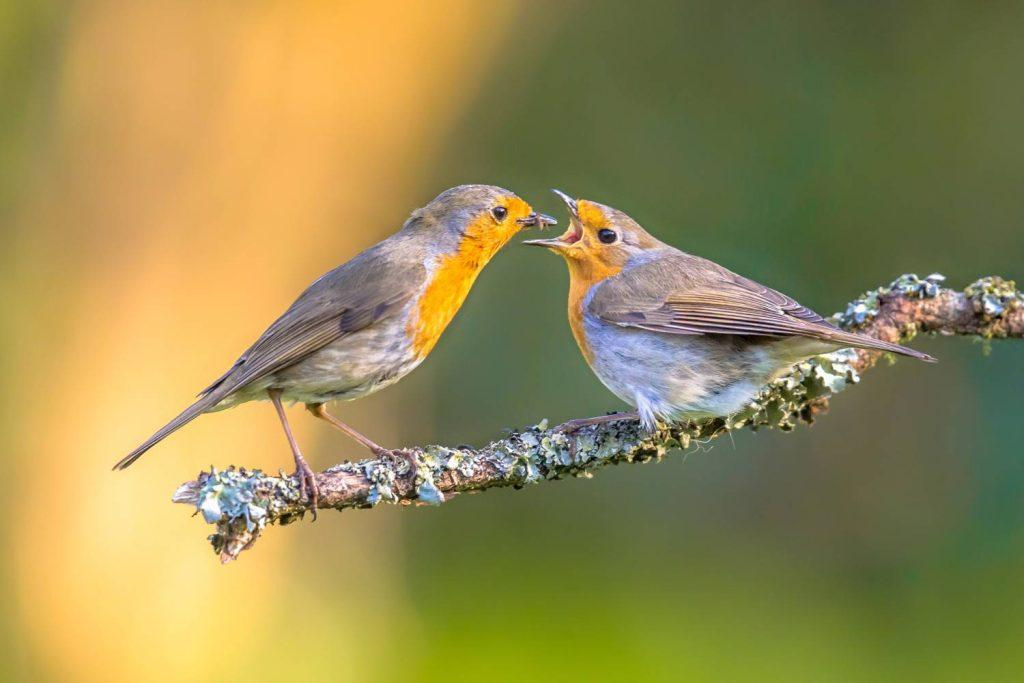
- Appearance: Famous for its bright red breast, often seen perched daintily on garden spades.
- Sounds: A sweet, melodic warble.
- Where to Find: Ubiquitous across the UK, loves visiting garden feeders.
- Preferred Foods: Mealworms, crushed peanuts, sunflower hearts.
- Habitats: Nest boxes with open fronts and dense bushes for shelter.
- Plants: Ivy, hawthorn, and cotoneaster for cover and berries.
Blue Tit (Cyanistes Caeruleus)

- Appearance: Vibrant blue and yellow plumage with a distinctive blue cap.
- Sounds: High-pitched trills and calls.
- Where to Find: Common in woodlands and gardens, often spotted on peanut feeders.
- Preferred Foods: Sunflower seeds, peanut granules, suet.
- Habitats: Small hole nest boxes, hanging feeders.
- Plants: Native trees like oak and willow for insects.
Blackbird (Turdus merula)
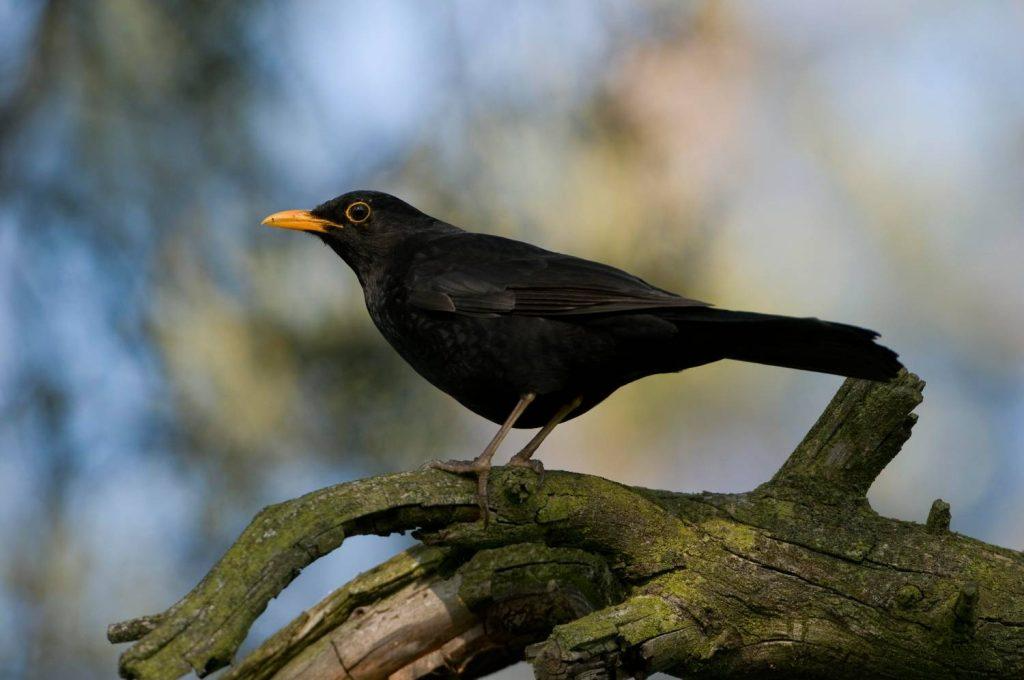
- Appearance: Males are black with a yellow beak; females are brown.
- Sounds: Rich, melodious song that varies dramatically.
- Where to Find: All regions; loves lawns and will sing from rooftops and trees.
- Preferred Foods: Dried mealworms, fruit, specially formulated blackbird food.
- Habitats: Thick shrubbery, open-fronted nest boxes.
- Plants: Fruit-bearing shrubs like rowan and berry plants.
Starling (Sturnus vulgaris)
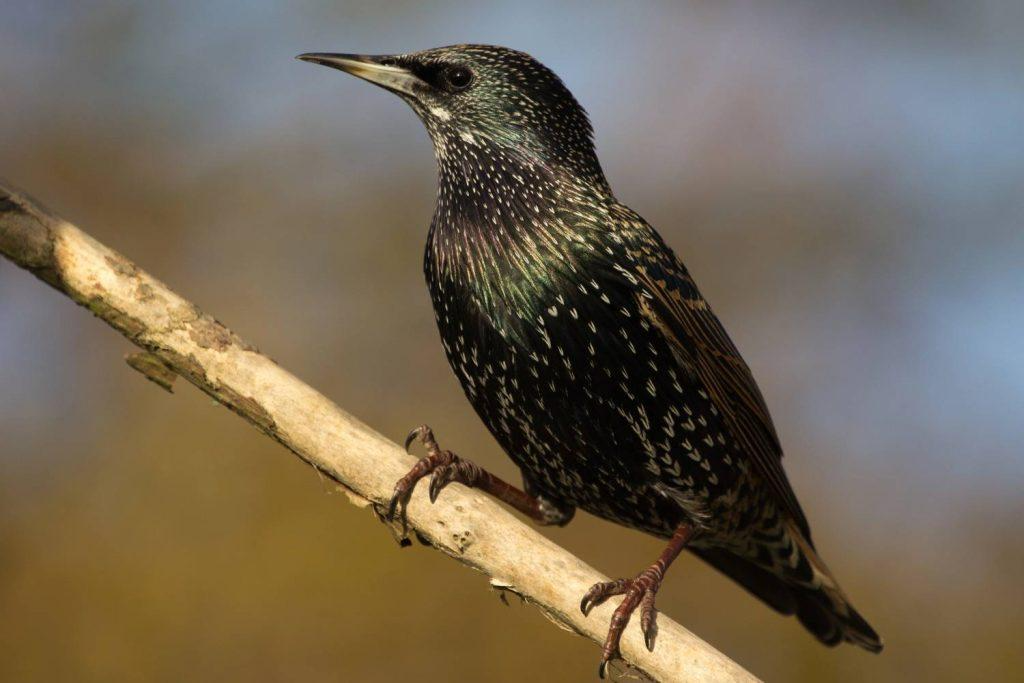
- Appearance: Glossy black feathers with a metallic sheen, speckled with white at times.
- Sounds: A mix of whistles, clicks, and mimicked sounds.
- Where to Find: Enjoys urban and suburban areas, often seen in noisy flocks.
- Preferred Foods: Suet blocks, insect-flavored pellets, minced meat.
- Habitats: Larger nest boxes, loose colonies for nesting.
- Plants: Aerial plants and trees where they can perch and sing.
House Sparrow (Passer domesticus)
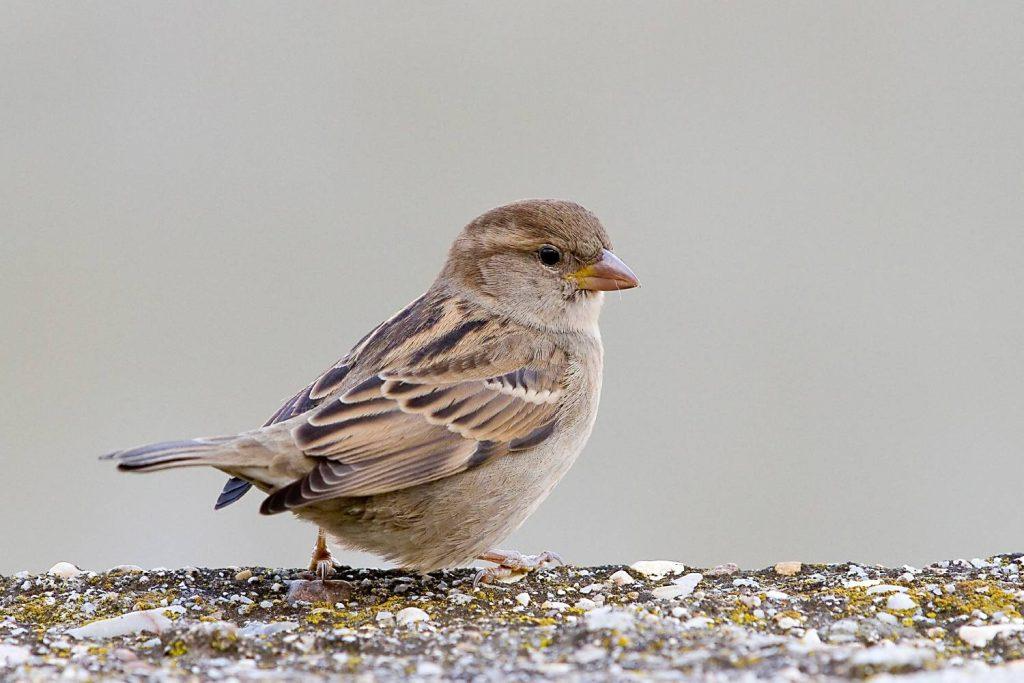
- Appearance: Males have a grey crown and black bib; females are dull brown.
- Sounds: Chirpy, incessant chirps.
- Where to Find: Near human habitation, from city centres to farmland.
- Preferred Foods: Mixed grain and seed, suet balls, breadcrumbs.
- Habitats: Dense hedges, communal nest boxes (sparrow terraces).
- Plants: Dense bushes and hedges like privet or hawthorn.
Goldfinch (Carduelis carduelis)
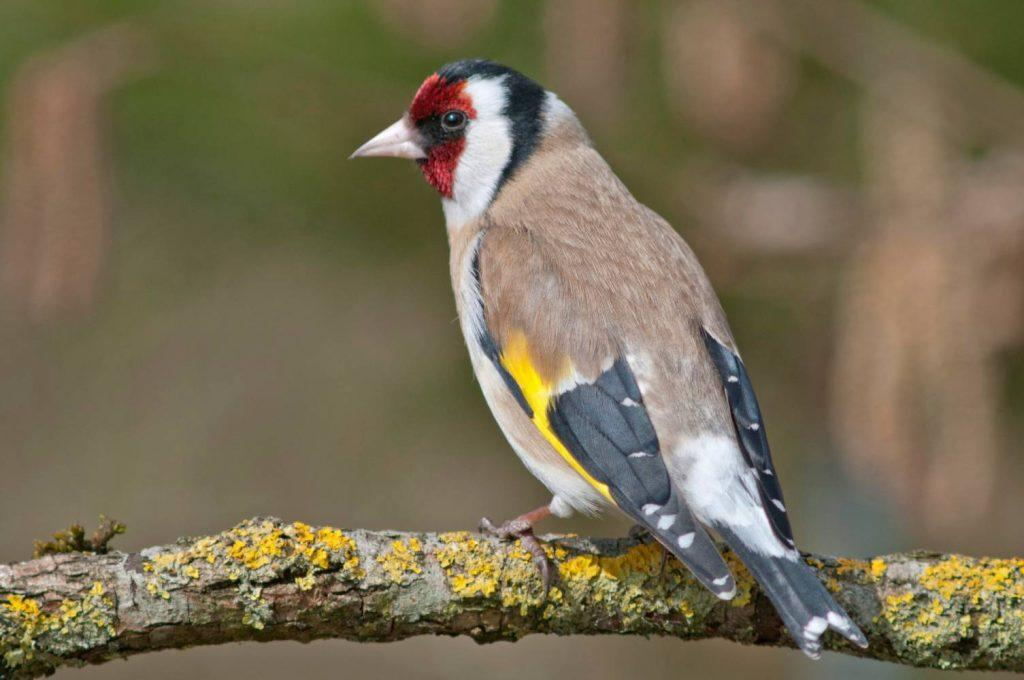
- Appearance: Bright red face with a yellow wing bar on black and white wings.
- Sounds: A pleasant, tinkling song and call.
- Where to Find: Fond of gardens; attracted to feeders with Nyjer seeds.
- Preferred Foods: Nyjer seeds, sunflower hearts, small seeds.
- Habitats: High perches and thistle patches for natural feeding.
- Plants: Thistles and teasels for seeds and nesting material.
Chaffinch (Fringilla coelebs)
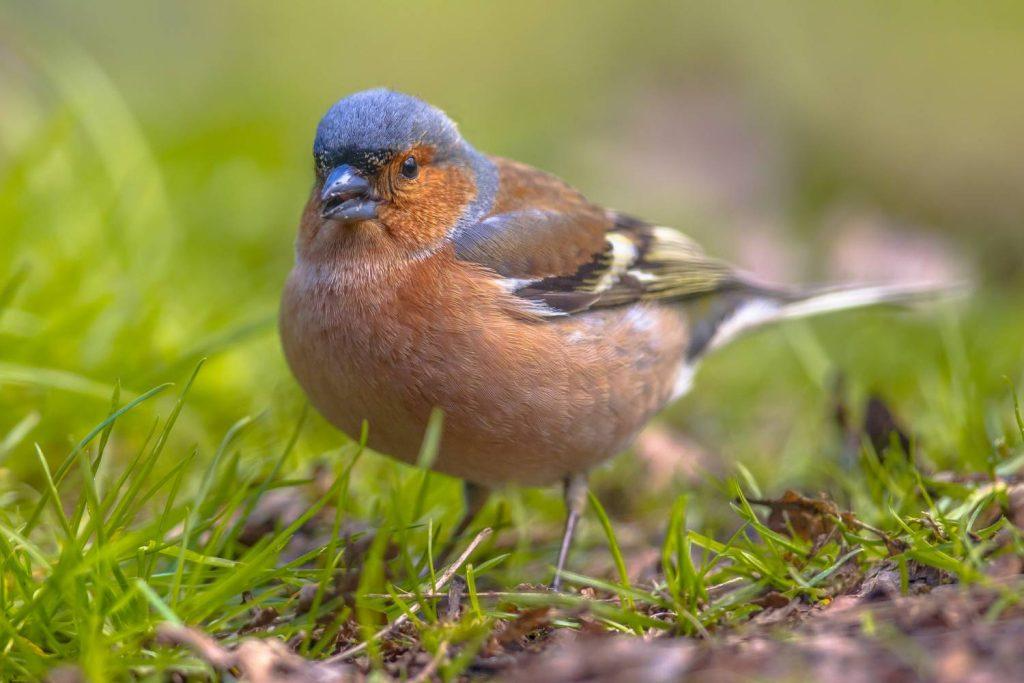
- Appearance: Males are brightly coloured with blue-grey caps and rust-red underparts, while females are more subdued.
- Sounds: A loud, cheerful song with a descending scale.
- Where to Find: Common in woodlands, parks, and gardens.
- Preferred Foods: Seed mixes, sunflower seeds, pinhead oatmeal.
- Habitats: Thick bushes, ground feeding areas.
- Plants: Native trees like beech and ash for seeds.
Great Tit (Parus major)

- Appearance: Largest UK tit; green and yellow with a striking black head and white cheeks.
- Sounds: A mix of repetitive pitch-altering calls like “teacher-teacher.”
- Where to Find: Loves visiting bird tables and garden feeders.
- Preferred Foods: Sunflower seeds, peanuts, suet.
- Habitats: Larger hole nest boxes, tall trees for shelter.
- Plants: Mixed woodland plants, caterpillar-rich trees.
Wren (Troglodyte troglodytes)
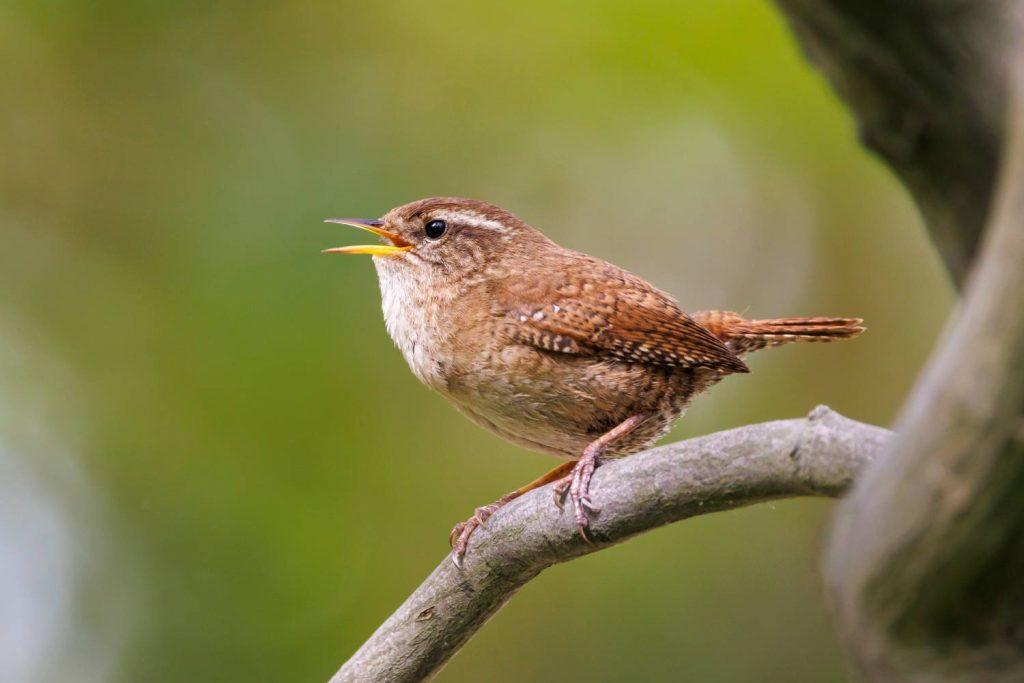
- Appearance: Small and compact with a short tail often cocked upward.
- Sounds: A surprisingly loud and clear song for its size.
- Where to Find: Very common, prefers dense bushes and woodlands but visits gardens.
- Preferred Foods: Small insects, mealworms, soft suet.
- Habitats: Undisturbed piles of brushwood, dense ivy.
- Plants: Dense, low shrubs and evergreens like boxwood.
Greenfinch (Chloris chloris)

- Appearance: Olive green, with yellow flashes on the wings and tail.
- Sounds: A wheezy, twittering song and call.
- Where to Find: Gardens and parks, particularly where seeds are available.
- Preferred Foods: Black sunflower seeds, peanuts, seed mixes.
- Habitats: Tree cavities, dense foliage for cover.
- Plants: Coniferous trees and dense hedges for nesting.
Song Thrush (Turdus philomelos)

- Appearance: Brown above with a cream underbelly speckled with black dots.
- Sounds: Distinctive song that includes repeated musical phrases.
- Where to Find: Wooded areas, parks, and large gardens.
- Preferred Foods: Insectivorous mix, fruit, suet.
- Habitats: Dense shrubbery, moist soil areas for foraging.
- Plants: Thick ground cover like ivy, native flowering shrubs for insects.
Magpie (Pica pica)
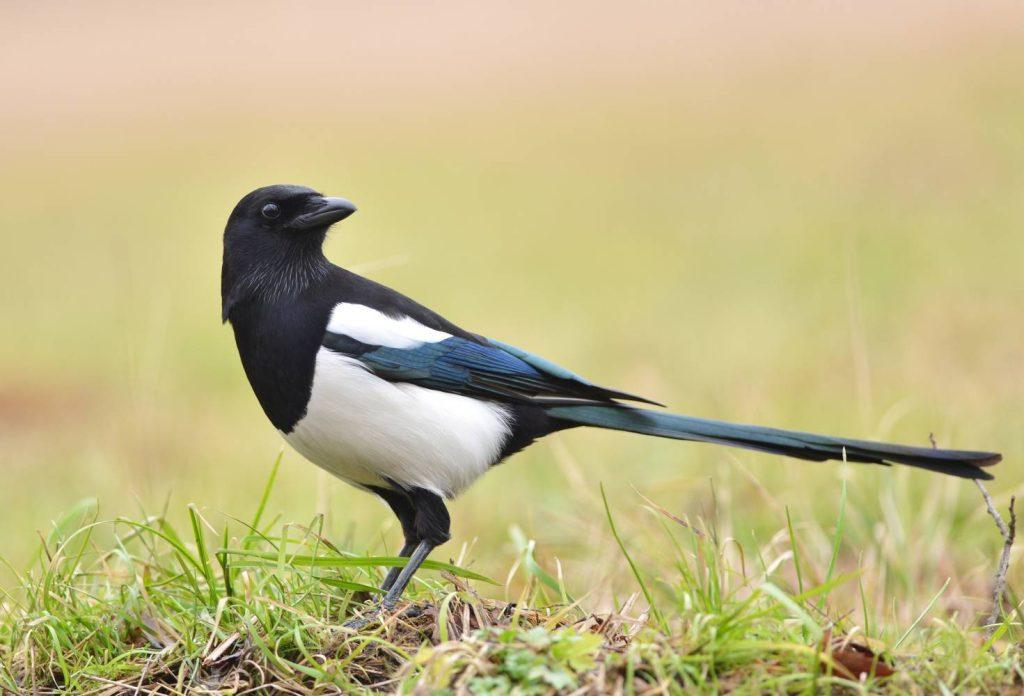
- Appearance: Large and unmistakable with black and white plumage and a long tail.
- Sounds: A chattering and rattling call.
- Where to Find: Everywhere from gardens to streets.
- Preferred Foods: Meat scraps, fat chunks, large seeds.
- Habitats: Tall trees for large nest construction.
- Plants: Tall trees and large shrubs for perching and surveillance.
Sparrowhawk (Accipiter nisus)
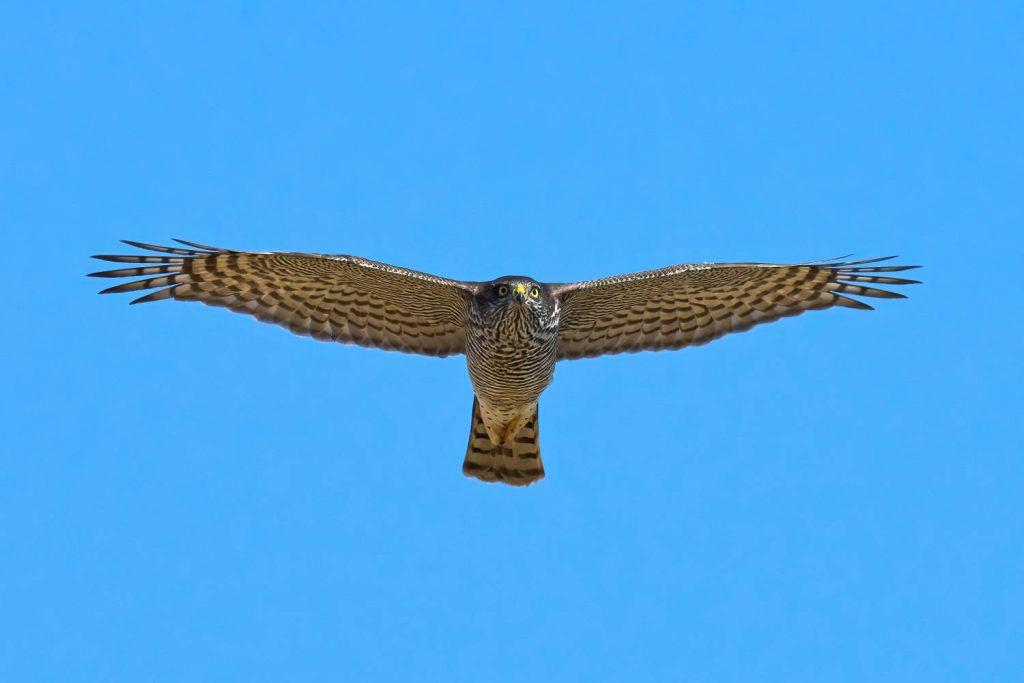
- Appearance: Small bird of prey, blue-grey above with orange-barred underparts.
- Sounds: Mostly silent but has a sharp, repeated call during breeding season.
- Where to Find: Woodlands and gardens; often seen darting over hedges.
- Preferred Foods: Not applicable (predatory bird).
- Habitats: Wooded gardens, tall tree canopies.
- Plants: Large, dense trees for nesting and hunting cover.
Coal Tit (Periparus ater)
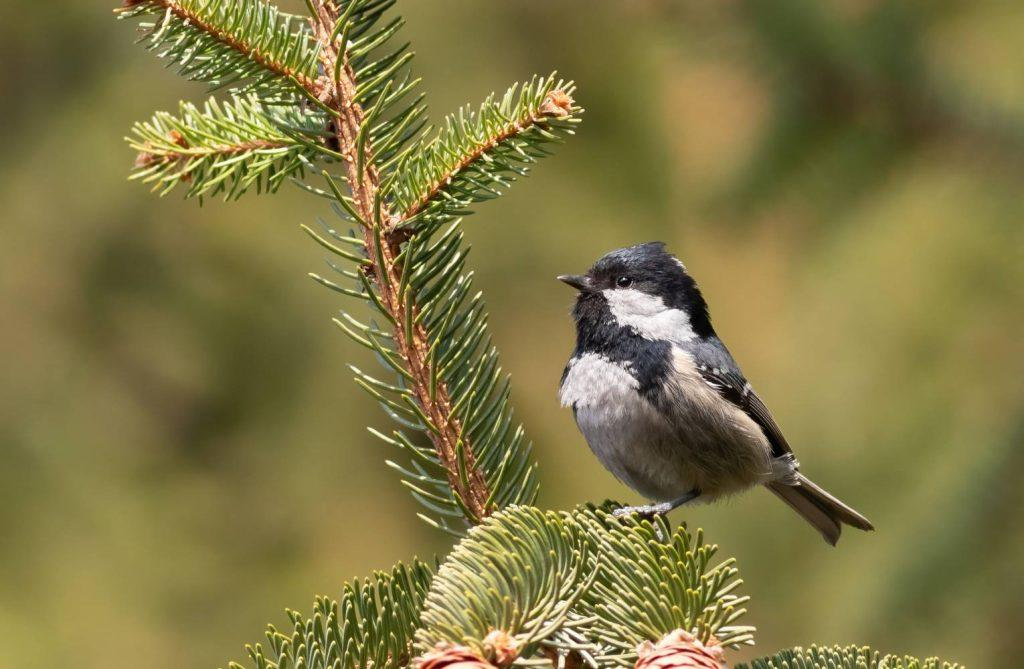
- Appearance: A small, grey-black tit with a distinctive white nape spot.
- Sounds: A simple and high-pitched “tee-tee-tee.”
- Where to Find: Prefers coniferous woods but visits garden feeders.
- Preferred Foods: Sunflower seeds, peanut pieces, suet.
- Habitats: Coniferous trees, small hole nest boxes.
- Plants: Pine and fir trees for natural insect sources.
Jackdaw (Corvus monedula)

- Appearance: Smaller than other crows, silvery-black with a shiny black cap.
- Sounds: A loud, nasal “chack.”
- Where to Find: Urban areas and countryside, including gardens with tall trees.
- Preferred Foods: Cheese scraps, seeds, and grains.
- Habitants: Chimneys, large tree cavities.
- Plants: Tall trees for nesting, open fields for foraging.
Long-tailed Tit (Aegithalos caudatus)
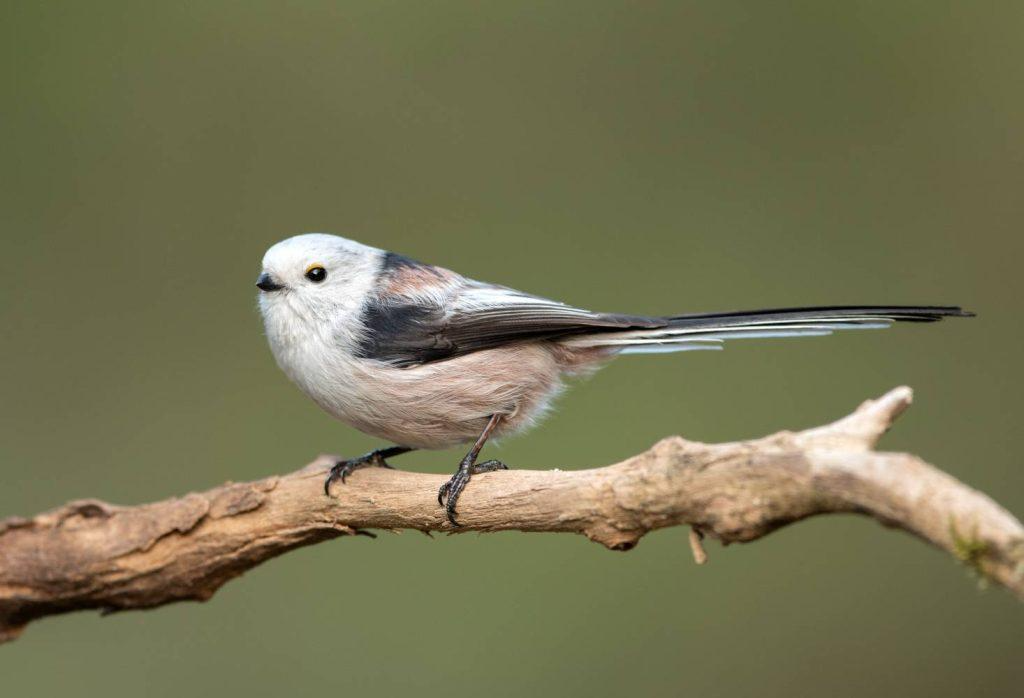
- Appearance: Distinctive with a long tail and fluff-ball body, mostly black, white, and pink.
- Sounds: A high-pitched twittering song.
- Where to Find: Woodlands, hedgerows, and gardens.
- Preferred Foods: Small insects, suet bits, soft seed mixes.
- Habitats: Thick shrubs, thorn bushes for intricate nests.
- Plants: Brambles and hawthorns for cover and food.
Pied Wagtail (Motacilla alba)
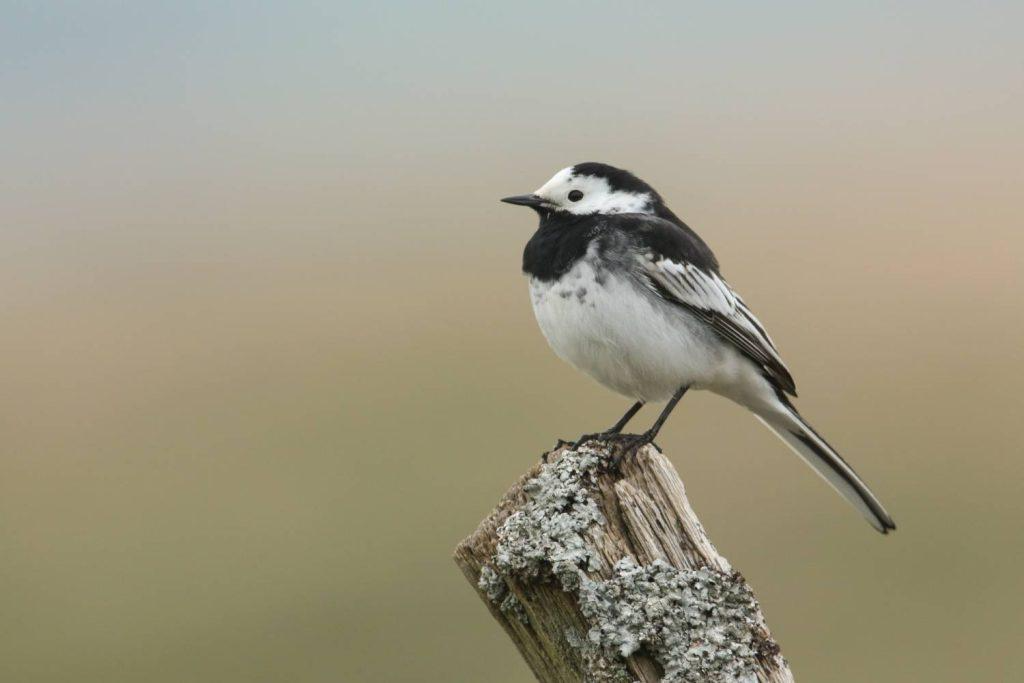
- Appearance: Sleek and slender with black and white plumage.
- Sounds: A cheerful “chis-ick” sound while foraging.
- Where to Find: Open areas like parks and gardens near water.
- Preferred Foods: Small insects, bread crumbs.
- Habitats: Flat roofs, open areas for foraging.
- Plants: Low-lying shrubs near water bodies.
Woodpigeon (Columba palumbus)
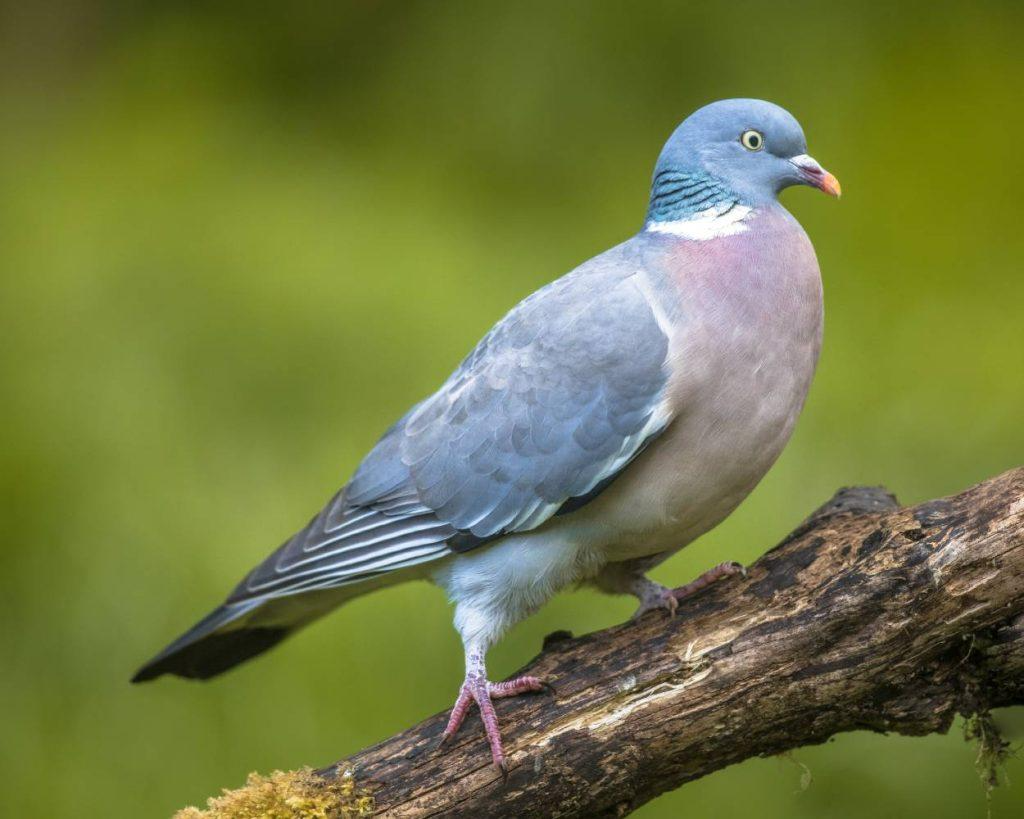
- Appearance: Large, with a grey body, pinkish breast, and distinctive white neck patch.
- Sounds: A deep, repetitive coo.
- Where to Find: Almost anywhere, but especially near food sources in gardens.
- Preferred Foods: Grain, seeds, certain vegetable crops.
- Habitats: Large sturdy trees for nesting.
- Plants: Large deciduous trees, fruit trees for foraging.
Collared Dove (Streptopelia decaocto)
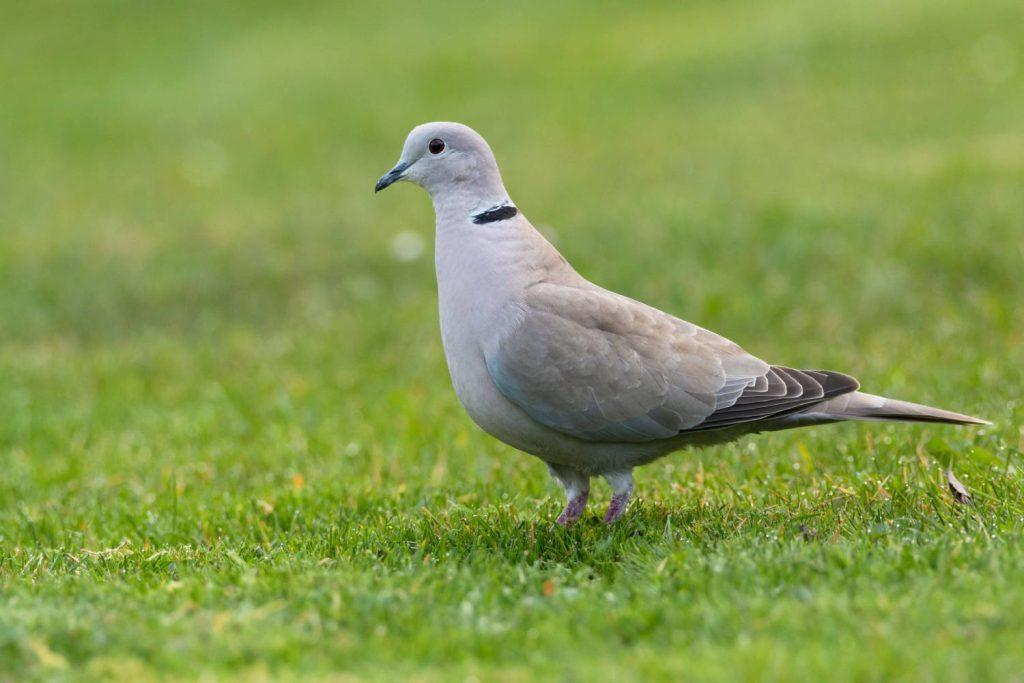
- Appearance: Smaller than a pigeon, pale grey with a distinctive black neck ring.
- Sounds: A persistent three-note cooing “coo-COO-coo.”
- Where to Find: Open woods, farms, and often in gardens.
- Preferred Foods: Seed mixes, grains, split peas.
- Habitats: Open ledges, tall trees for nesting.
- Plants: Open lawns and grain-rich feeders.
Dunnock (Prunella modularis)

- Appearance: Unassuming small bird with grey underparts and brown streaks.
- Sounds: A fast, thin, warbling song.
- Where to Find: Under hedges and bushes in gardens.
- Preferred Foods: Fine seed mixes, insects.
- Habitats: Dense undergrowth, low shrubs.
- Plants: Dense, native ground cover like ivy and brambles.
Bullfinch (Pyrrhula pyrrhula)

- Appearance: Robust body with bright pinkish-red underparts and a black cap.
- Sounds: A soft, mournful call.
- Where to Find: Woodlands and large gardens with thick shrubbery.
- Preferred Foods: Sunflower seeds, soft fruits, suet.
- Habitats: Thick shrubs, hedgerows for shelter.
- Plants: Fruit trees and bushes, dense bushes for protection.
Nuthatch (Sitta europaea)

- Appearance: Compact and agile with blue-grey upperparts and chestnut lower parts.
- Sounds: A sharp “twit” sound, often repeated.
- Where to Find: Deciduous woods and gardens with mature trees.
- Preferred Foods: Sunflower seeds, peanuts, insects.
- Habitats: Tree trunks with crevices, wooden crevice nest boxes.
- Plants: Mature woodland trees, especially oak and beech.
Jay (Garrulus glandarius)
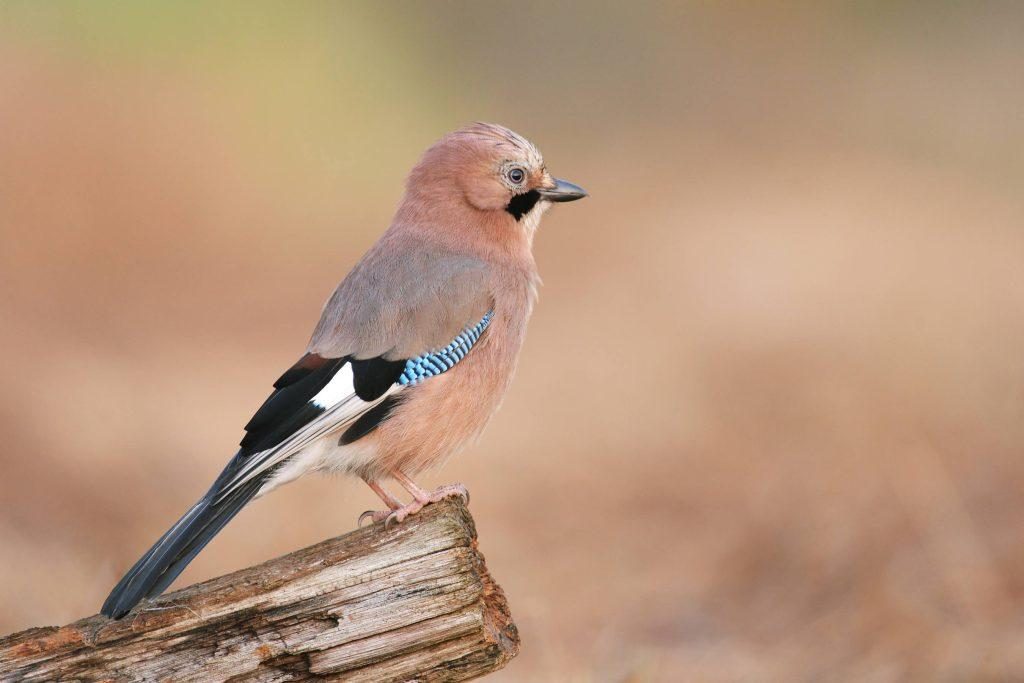
- Appearance: Colourful with pinkish body and striking blue wing patch.
- Sounds: A loud, screeching call.
- Where to Find: Woodlands, parks, and occasionally visits larger gardens.
- Preferred Foods: Acorns, nuts, suet.
- Habitats: Wooded gardens with mature trees.
- Plants: Oak trees for acorns, large trees for caching food.
Mistle Thrush (Turdus viscivorus)
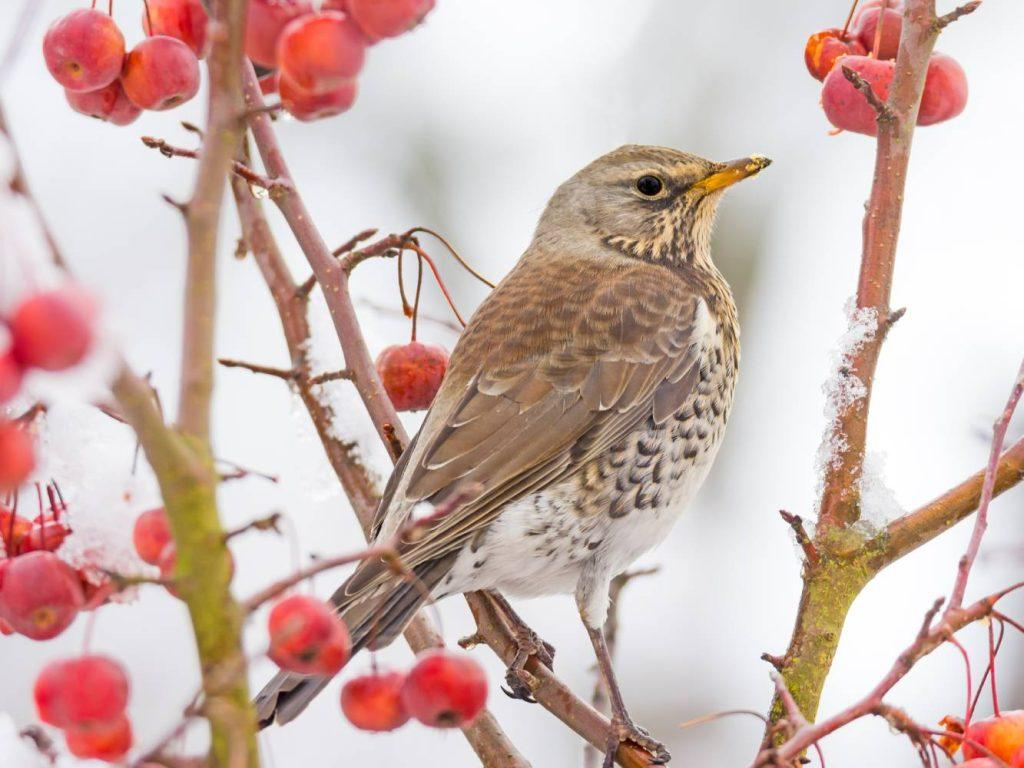
- Appearance: Larger than the song thrush, pale grey-brown with bold spots on its underparts.
- Sounds: A loud, fluty song, often heard in stormy weather.
- Where to Find: Parks, large gardens, and woodlands.
- Preferred Foods: Berries, suet, and worms.
- Habitats: Tall trees for high nests, open grasslands.
- Plants: Rowan and holly for berries, large lawns for foraging.
Rook (Corvus frugilegus)
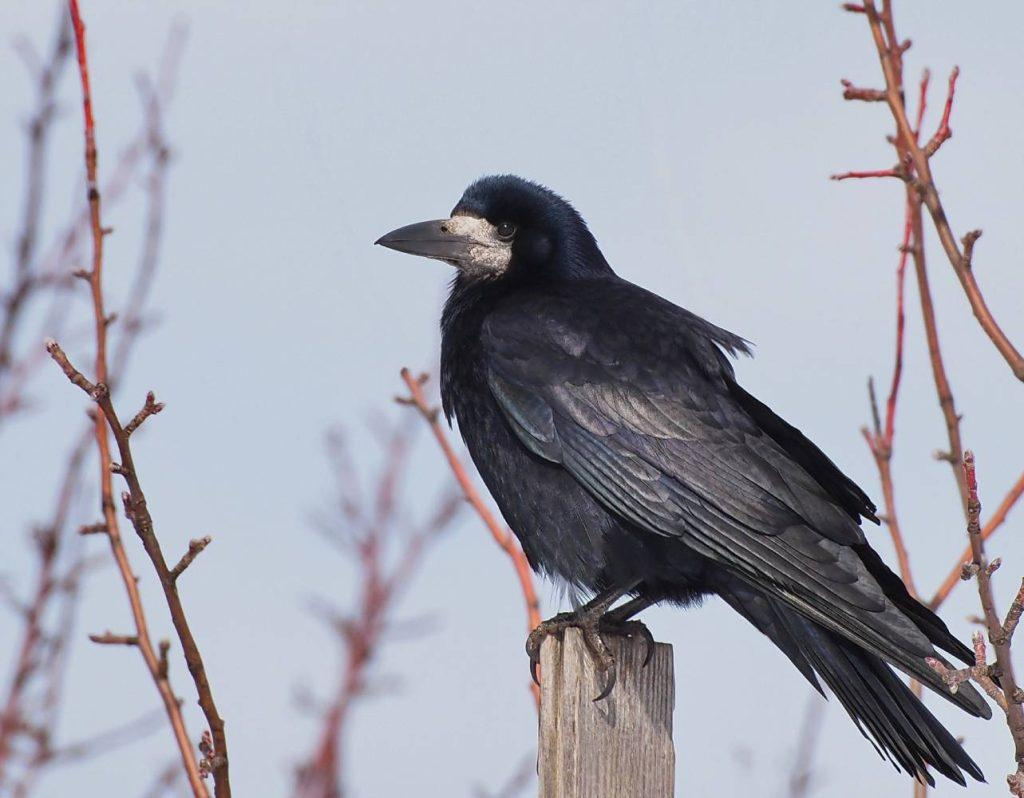
- Appearance: Similar to crows, but with a bare, greyish face.
- Sounds: A raucous “kaah-kaah” call.
- Where to Find: Countryside and farmlands, occasionally visits larger gardens.
- Preferred Foods: Earthworms, grain, birdseed.
- Habitats: Tall trees in colonies known as rookeries.
- Plants: Large fields and trees, particularly near agricultural areas.
Bird Identification Guide
Becoming a bird identification expert might sound daunting, but it’s a lot of fun and incredibly rewarding! This guide will equip you with the tools and knowledge to identify the birds visiting your garden. Let’s break down the bird identification process into easy-to-follow steps that will have you recognising your feathered visitors in no time.
Key Identification Features
- Size & Shape: Begin by observing the bird’s size relative to familiar species (is it sparrow-sized or as big as a pigeon?) and its overall shape (does it have a long tail like a magpie, or is it round and compact like a wren?).
- Colour & Markings: Next, note the colour patterns: What are the dominant colours? Does it have any distinctive markings, like the blue tit’s blue cap or the blackbird’s all-black plumage?
- Behaviour: Watch how the bird moves and behaves. Does it hop along the ground like a robin or climb trees like a nuthatch? Observing feeding habits can also give clues; finches often feed on seeds, whereas thrushes might be seen tugging worms from the ground.
- Song & Call: Birds can often be identified alone by their song or call. Each species has unique vocalisations, which can be a huge clue to its identity, especially when the bird is hidden.
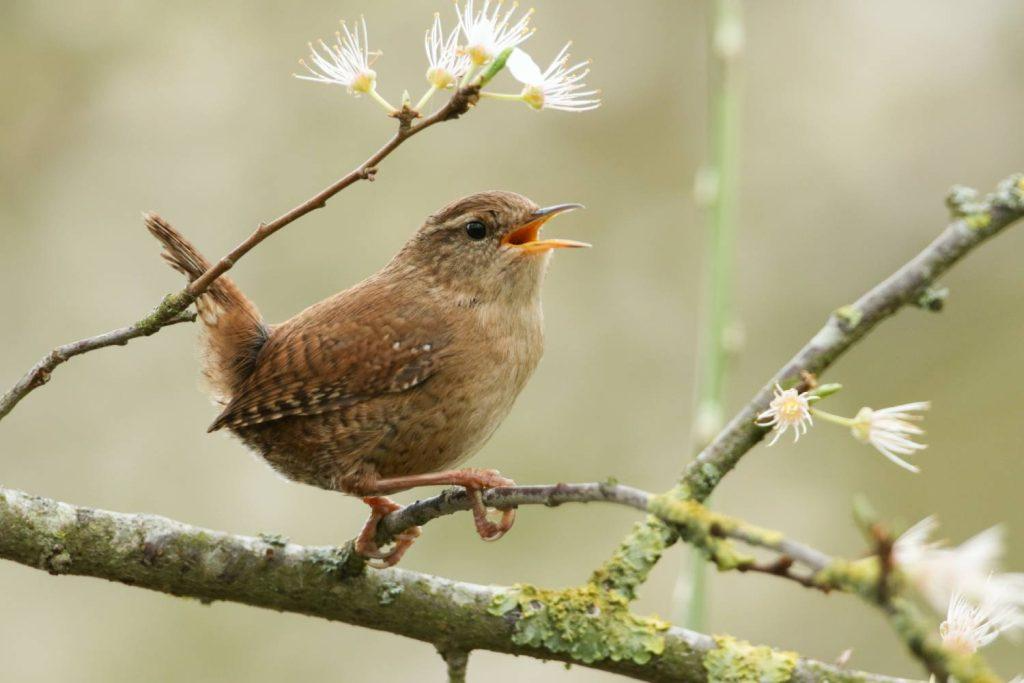
Tools for Bird Identification
- Binoculars: A good pair of binoculars brings distant birds into clear view, making it easier to note identifying features.
- Field Guides: Carry a field guide specific to UK birds, or download an app such as the RSPB’s Bird Identifier RSPB Bird Identifier.
- Birding Apps: Apps like Merlin Bird ID and iBird UK guide you through a series of questions about the bird and offer a list of possible matches based on your observations.
Tips for Birdwatching
- Practice Regularly: The more you observe birds, the quicker you learn to identify them. Regular practice in your garden can sharpen your skills.
- Take Notes or Photos: Keeping a birdwatching journal or taking photographs can help you remember features and verify your sightings.
- Join Birdwatching Groups: Participate in local birdwatching groups or online forums to learn from experienced birdwatchers.
- Engaging with the Community: Birdwatching can be solitary, but sharing with others is also fun. Why not check out local birdwatching clubs or online communities? The British Trust for Ornithology (BTO) offers resources and community connections for novice and expert birdwatchers BTO Birdwatching Resources.
- At Gardening Express, we would love to hear about your successes in your garden. Why not post images of the birds visiting your garden on our Facebook page to share with other garden wildlife enthusiasts? You are welcome to ask for help in identification and share what you have done that has worked to encourage more wildlife. With these tools and tips, you’re on your way to becoming a proficient bird identifier. Remember, every bird you recognise brings you closer to understanding the rich tapestry of wildlife that shares our spaces. Happy birdwatching!
How to attract wild birds into your garden.
How to create a bird-friendly garden
Transforming your garden into a sanctuary for birds provides the best viewing platform. Our guide below explains how to design a garden that attracts diverse bird species and encourages their return time and again.
If you get the formula right in your garden with food, habitats and water, you stand an excellent chance of attracting rare wild birds into your garden and being the envy of your neighbours.
Choosing the Right Plants
Birds are attracted to gardens that replicate their natural habitat. Here are some tips on selecting plants:
Native Species: Opt for native shrubs, trees, and flowers as they provide the best support for local wildlife, including insects, which many birds feed on. Shrubs and trees provide the materials and environment to construct safe nests. Providing height in the garden is essential for bird safety.
Berry Producers: Plants like holly, pyracantha, and elderberry offer vital food sources through their berries. Providing birds with food through your planting is a great attraction for birds; complement this approach with additional bird feeders stocked with tasty bird food.
Nectar Sources: Flowering plants such as lavender, foxgloves, and honeysuckle attract insects, which draw insectivorous birds.
Importance of Water Sources
Water is as crucial as food for garden birds. It is not just for drinking but also for bathing and keeping their feathers in perfect condition. Regular bathing allows birds to remove parasites, dirt, and dust from their feathers, allowing for better insulation in winter and overall better flight.
Bird Baths: Install a bird bath or two, ensuring they are shallow and have rough surfaces for grip.
Ponds: If space allows, a small pond can attract a broader range of wildlife and offer birds a tranquil spot to drink and bathe.
Providing accessible and safe water allows birds to regulate their temperatures better throughout the changing seasons and ensure their feather stay in great condition.
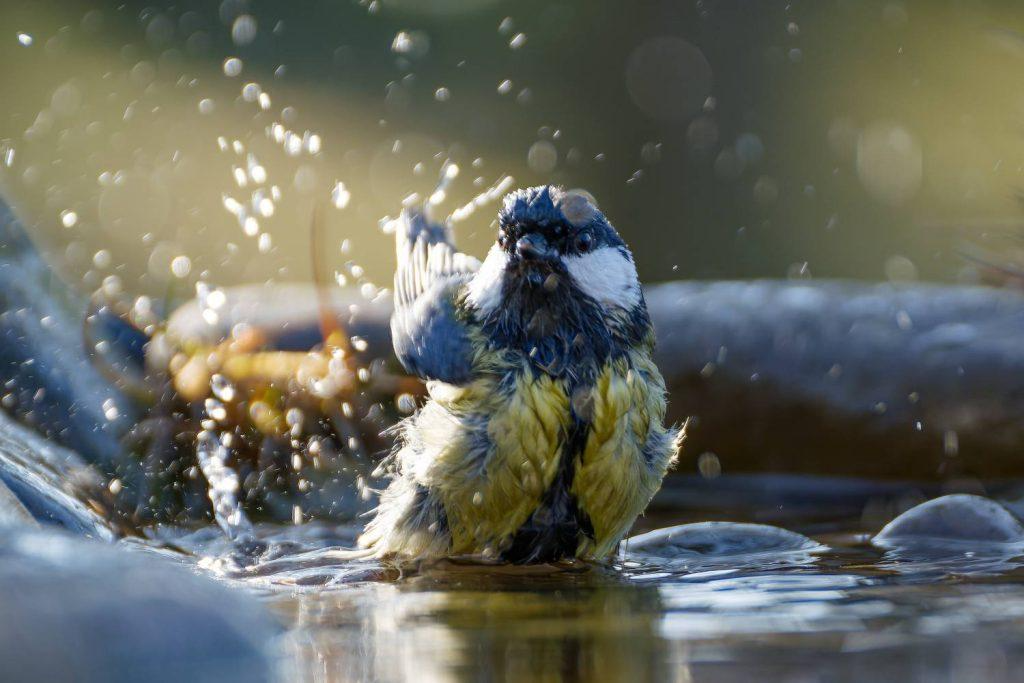
Providing Shelter and Nesting Materials
Dense Cover: Thick hedges and dense shrubs offer safe nesting sites and protection from predators.
Nesting Boxes: Position various nesting boxes around the garden to accommodate different bird species. Ensure they are out of reach of cats.
Loose Materials: Leave piles of leaves, twigs, and other natural materials for birds to use in building their nests.
Predator Control
To make your garden a safe haven for birds, consider the following:
Cat Deterrents: Use plant cover, prickly bushes, or commercial cat deterrents to discourage cats from stalking birds in your garden.
Feeder Placement: Place bird feeders in open spaces away from places where predators can hide, yet close enough to shelter that birds feel safe visiting.
Seasonal Considerations of Wild Birds in the garden
Spring: Clear out old nests from boxes and provide fresh water regularly.
Summer: Keep birdbaths full to help birds cope with the heat.
Autumn: Plant berry-producing plants that will provide food throughout the winter.
Winter: Ensure food and water sources are not frozen and provide fatty foods to help birds maintain their energy levels.
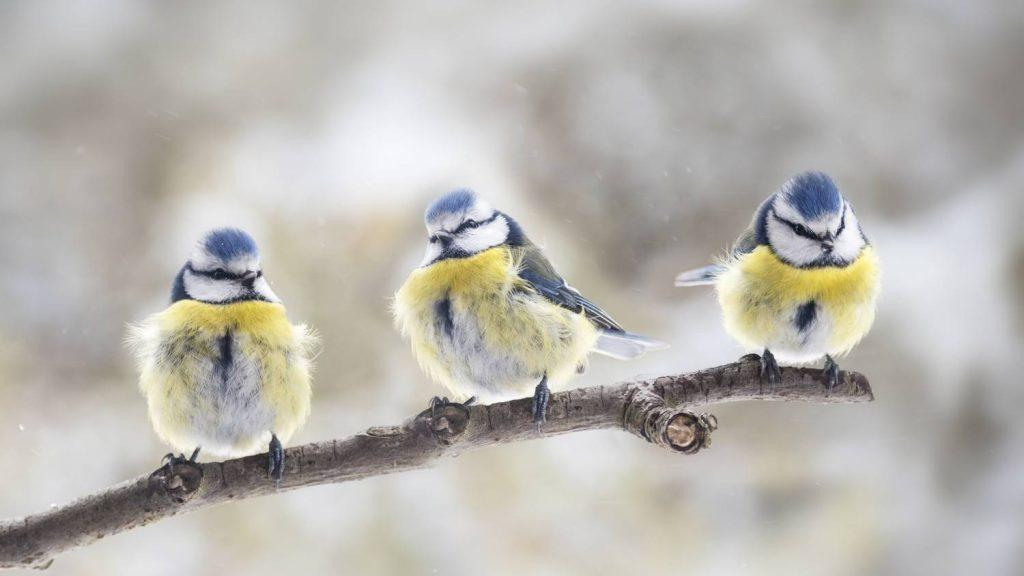
Engage with Conservation Efforts for Wild Birds
Wild bird numbers are falling across the UK as wild habitats are lost. You garden can be the perfect sanctuary for wild birds to come and visit safely. Learn about and participate in local conservation efforts to protect bird habitats. Organisations like the Royal Horticultural Society offer great tips on creating wildlife-friendly gardens RHS Gardening for Wildlife.
By creating a bird-friendly environment, you enhance your garden’s appeal and contribute to the broader ecosystem by supporting local wildlife. Enjoy the chirps and songs that fill your air, and take pride in knowing your garden is a sanctuary for these beautiful creatures. Happy gardening!
Understanding Bird Behavior
Get ready to become a backyard ornithologist! Observing and understanding the behaviours of birds in your garden isn’t just fascinating—it can also enhance your birdwatching experience and help you better cater to their needs. Let’s dive into some common bird behaviours and what they mean.
Common Bird Behaviors Explained
- Feeding Habits: Watch how different birds eat to learn what food to provide. Finches often peck at seed heads, while robins forage for insects on the ground. Observing these habits can help you choose the most appropriate feeders and food types.
- Bathing: Birds bathe to maintain feather health, which is crucial for insulation and flight. You might see birds fluttering and splashing in a birdbath, which is as fun for them as entertaining for us to watch!
- Singing and Calling: Birds sing for various reasons, including claiming territory, attracting a mate, or signalling danger. Each species has a distinct song or call, which, once familiar, can help you identify them even without seeing them.
- Nesting: Watch for birds carrying nesting materials during the breeding season. This behaviour is a clue to making your garden more bird-friendly by providing materials like twigs, moss, and leaves.
- Migratory Patterns: Some birds in your garden may only appear seasonally. Understanding these patterns can tell you when to expect certain species and when to provide specific foods to help them fuel up for long journeys.
Interpreting Bird Calls and Songs
Bird calls can be complex, but learning them adds another layer to your birdwatching skills. Here’s how to start:
- Use a Birdsong App: Apps like ChirpOMatic for the UK are designed to identify bird songs and calls automatically.
- Regular Listening: Spend time in your garden listening to the birds. Over time, you’ll begin to distinguish between different calls and what they mean.
Activities to Enhance Understanding of Wild Birds
- Feeder Watch: Set up feeders visible from a window and watch how birds interact. Note who visits and at what times of day to learn about feeding patterns.
- Bird Baths: Observe how different species use a bird bath. Some might dip in and out quickly, while others linger for a longer splash.
- Create a Bird Journal: Record the birds you see, their behaviours, and the times of the year they visit. This can be a rewarding way to track changes and patterns over time.
Further Learning Resources
The British Trust for Ornithology (BTO) offers information on bird behaviours and how to identify them. Check out their guide here: BTO Bird Behaviour Guide.
By tuning into the daily lives of the birds in your garden, you not only get to enjoy their antics but also contribute to their well-being by providing a supportive habitat. So grab your binoculars and a cup of tea, and prepare for some delightful avian antics in your backyard!
Frequently Asked Questions about Garden Birds
Whether you’re new to birdwatching or looking to expand your knowledge, you’ll always have questions about how to attract and care for garden birds. Here, we address some of the most common queries with straightforward and useful advice, helping you make the most of your birdwatching experience.
Q1: What is the best food to feed garden birds?
A: The best food depends on the bird species you aim to attract. Generally, a mix of seeds (such as sunflower and nyjer seeds), suet balls, and kitchen scraps like unsalted bacon rind and grated cheese can attract various birds. Avoid bread as it offers little nutritional value. Always provide fresh water alongside food. For more specific guidance, the RSPB offers an excellent resource on feeding birds here.
Q2: How can I attract more species of birds to my garden?
A: Diversity in planting and food sources is key. Include native shrubs, trees, and flowers to provide natural shelter and food sources like berries and insects. Additionally, it offers a range of feeding options at different heights and locations, using hanging feeders for seeds and nuts, ground feeders for mealworms, and fruit on bird tables.
Q3: When is the best time to put out bird feeders?
A: You can feed birds all year round, but it is especially important during the winter when natural food sources are scarce. Provide high-protein foods like mealworms to help with breeding in spring and early summer. Always ensure food is fresh and feeders are clean to prevent disease.
Q4: How do I prevent squirrels from raiding bird feeders?
A: Squirrel-proof bird feeders, specifically designed to prevent squirrels from accessing the food, are highly effective. You can also hang feeders from a wire that squirrels cannot climb or use baffles (domes or disks) above or below feeders to block their path.
Q5: What should I do if I find a sick or injured bird in my garden?
A: Avoid handling the bird more than necessary. Place it in a well-ventilated box lined with a towel and keep it in a quiet, safe place. Do not attempt to feed it. Contact the RSPCA or a local wildlife rehabilitator for advice on proceeding. For more information on how to help injured wildlife, visit this RSPCA page.
Q6: How can I make my garden safer for birds?
A: Ensure there are no loose nettings where birds can get entangled. Use decals on large windows to prevent birds from flying into them. Keep cats indoors or install a bell on their collar to give birds a warning. Plant dense shrubs or provide nesting boxes for shelter.
Q7: Can I provide nesting materials in my garden?
A: Providing nesting materials can be very helpful, especially in early spring. Offer materials like wool, pet hair, or feathers in mesh bags or dedicated nesting material dispensers. Avoid using anything processed or synthetic, like dryer lint, which can retain water and chill nestlings.
You’ll be well-equipped to enjoy and support the garden birds visiting your outdoor space by answering these common questions. Remember, each small effort contributes to the well-being of the local bird population, enhancing your garden’s biodiversity and your own enjoyment of this vibrant ecosystem.
Dealing with Dead Wild Birds: In the UK, if you find a dead wild bird in your garden, you should not touch it directly. Use gloves or an inverted plastic bag to handle the bird. It’s essential to check government guidance, especially during bird flu outbreaks. For safe disposal, either bury the bird deep enough to prevent scavenging or place it in a sealed bag in the bin. More information can be found on the UK government’s website or by contacting the RSPCA.
Dealing with Injured Wild Birds: For injured wild birds, avoid handling them more than necessary. Place them in a well-ventilated box lined with a towel without feeding them and keep them in a quiet, dark place. Contact the RSPCA or a local vet immediately for further assistance. They can provide appropriate care and advice on the next steps.
For more guidance, you can visit:
Conclusion: The Joys and Benefits of Garden Bird Watching
As we wrap up our comprehensive guide to garden birds in the UK, it’s clear that engaging with our feathered visitors offers much more than just the pleasure of their company. Bird watching in your garden can be a gateway to greater environmental awareness, a step towards enhancing local biodiversity, and a source of immense personal joy and relaxation.
Recap of Key Points
Identification and Diversity: We’ve explored how to identify the 25 most common garden birds, noting their unique traits and behaviours.
Feeding: We’ve learned what foods to offer to attract and nourish these birds throughout the year.
Creating a Haven: By making our gardens bird-friendly with the right plants, shelters, and water sources, we contribute to wildlife conservation on a local scale.
Why Bird Watching Is More Than Just a Hobby
Environmental Impact: Every bird-friendly garden acts as a mini nature reserve, helping to support and increase bird populations. This, in turn, aids in controlling pests naturally, pollinating plants, and maintaining ecological balance.
Educational Value: For families, bird watching is a fantastic way to educate children about nature and ecology in an engaging way. It encourages observation skills and scientific inquiry.
Health Benefits: The therapeutic benefits of bird watching, including stress reduction and improved mental well-being, are well-documented. It’s a relaxing activity that can be enjoyed by people of all ages and from all walks of life.
Get Involved
Whether you’re a seasoned bird watcher or a curious newcomer, there are many ways to deepen your engagement with this rewarding pastime:
Join Local Groups: Connect with local bird-watching clubs and participate in community science projects like those organised by the RSPB.
Expand Your Knowledge: Continuously learn about birds and their habitats. The more you know, the more fulfilling your bird-watching experience will be. Resources like the British Trust for Ornithology offer extensive learning materials and events BTO Resources.
Final Thoughts
We hope this guide inspires you to open your garden to the beautiful world of birds and discover the myriad benefits they bring. Remember that each small action contributes to a larger purpose as you fill your feeders, plant new shrubs, or pause to watch a robin flit by. Bird watching is not just about the birds; it’s about connecting with the natural world and finding joy in the everyday wonders of life.
Thank you for taking the time to explore our guide. Happy bird watching, and may your garden be a lively, bird-filled sanctuary that brings as much joy to the birds as it does to you!
Get Involved and Share Your Birdwatching Journey
Congratulations on completing your journey through our extensive guide to garden birds in the UK! Now that you know about identifying, feeding, and caring for these delightful creatures, why not take the following steps? Here’s how to further engage with the birdwatching community and share your experiences to inspire others.
Share Your Sightings
Social Media: Join the vibrant online community of birdwatchers by sharing your sightings, photos, and experiences on platforms like Instagram, Twitter, or Facebook. Use hashtags like #UKGardenBirds or #BirdwatchingUK to connect with others and increase the visibility of your posts.
Bird Apps and Websites: Platforms like eBird or the RSPB’s Birdtrack allow you to record and share your bird sightings. This contributes to citizen science projects and helps you keep a personal record of your observations. Check out Birdtrack here.
Participate in Local Events
Birdwatching Walks and Talks: Watch events hosted by local nature reserves, parks, and wildlife trusts. These activities are great opportunities to learn from experts and meet fellow bird enthusiasts.
Volunteer: Many conservation groups need volunteers for various activities, ranging from habitat restoration to guiding bird walks. This is a fantastic way to give back to the community and gain deeper insight into bird conservation efforts.
Encourage Others to Start Birdwatching
Invite Friends and Family: Share your passion for birdwatching with friends and family. Even a simple activity like setting up a new bird feeder can spark interest and lead to a shared hobby.
Educational Workshops: If you’re experienced, consider hosting a workshop in your local community centre to teach others about the joys and techniques of birdwatching.
Stay Curious and Keep Learning
Read and Research: The world of birds is vast and full of wonders. Continue your education by reading books, watching documentaries, and following bird-related news.
Visit Bird Sanctuaries and Reserves: Explore different habitats by visiting nature reserves across the UK. Each visit can offer new insights and sightings, enriching your understanding of bird behaviour and habitat needs.
Let’s Spread the Word
Sharing our experiences and knowledge can inspire more people to join the birdwatching community, fostering a greater appreciation for wildlife and the natural world. Your garden, no matter how big or small, can be a sanctuary for birds and a place of discovery and delight.
So, what are you waiting for? Grab your binoculars, step into your garden, and start observing the fascinating world of garden birds. Share your stories and photos, and encourage others to do the same. Let’s make our gardens thriving havens for the UK’s wonderful birdlife!